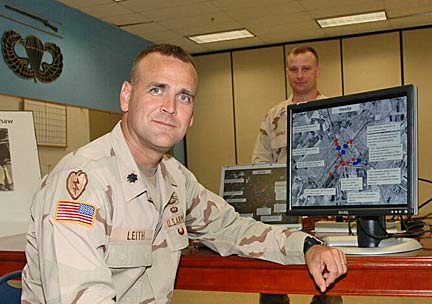
|
Schofield soldiers
recount chaos in Iraq
A battle for Hawija was one
of the most decisive in the war
Last year, Schofield Barracks Sgt. Roberto Zuniga had hoped to celebrate his 24th birthday at home in Texas on leave and away from the combat zones of Iraq.
Instead, on April 7, Zuniga, 25, found himself assigned to the top of a three-story building in Hawija, about 30 miles west of the northern Iraqi city of Kirkuk.
Before him was a demonstration of Shiites and Sunni Muslims in which Mahdi army banners were displayed in support of Shiite cleric Muqtada al-Sadr.
The demonstrators on that day had hoped to rally enough support throughout Iraq to bring down coalition forces and set world opinion against the U.S. efforts.
During the next 10 hours, Zuniga and other members of the 25th Infantry Division's 1st Battalion, 27th Infantry, would be involved in critical house-to-house and close street fighting.
It was the first major engagement for the "Wolfhounds" since the Schofield Barracks unit arrived in Iraq in February 2004.

Lt. Col. Scott Leith, commander, 1st Battalion, 27th Infantry, says the battle for Hawija proved coalition forces' worth.
The battle would become part of the Wolfhounds' colorful 100-year history that has led to 29 battle streamers, three presidential unit citations and 14 Medals of Honor.
Just a few days earlier, on March 31, insurgents had brutally killed Big Island resident Wesley Batalona, 48, and three other American contract security workers in Fallujah. Their bodies were burned, and two hung from a bridge.
Leith said the battle, which began with a demonstration of 150 people, occurred near the one-year anniversary of the fall of Baghdad, located 155 miles south of Hawija.
Leith, in recalling the events of the battle, said the anti-coalition Shiite and Sunni Muslim forces "had been fueled by the gains in Fallujah a few days earlier."
"It was later learned," Leith said, "the insurgents had brought in 100 well-armed fighters hoping to link up with terrorist cells in the city."
The military's suspicion was later confirmed early in the afternoon when Tropic Lightning soldiers detained a video cameraman for the al-Jazeera television network, who also was carrying seven AK-47 rifle magazines.
That same afternoon, Leith said, the Arab television network was reporting that a local Iraqi general and other insurgents were claiming that Hawija and neighboring cities had fallen, which was "farthest from the truth."
Zuniga and other members of the 2nd Platoon assigned to the Wolfhounds' Alpha Company had been assigned to provide security for a normally scheduled weekly city council meeting.
But there were clues even before the platoon got there that everything wasn't right, said Zuniga, who has been in the Army for six years.
"Normally, there are guys and kids waving to us as we drive by," said the Waco, Texas, native. "But that day it was quiet. Many of the stores were closed and there were not many people around."
Stationed on the roof of the city council building, Zuniga heard over the radio that a rocket-propelled grenade had been fired. As he surveyed the horizon, Zuniga said, "I saw something sticking out about five blocks."
Trained as a sniper, he fired off what is believed to be the first shot of the battle for Hawija, killing the insurgent.
"All of a sudden, it looked like the Fourth of July," he added. "There was small arms fire everywhere. There were RPGs (rocket-propelled grenades) bursting right about my head or whistling above me."
Leith immediately called for reinforcements from Forward Operating Base McHenry, located nearly 4 miles away,
Sgt. Ryan Goede, of Tucson, Ariz., and Spc. Craig Henderson, of New Albany, Ind., were members of Alpha Company that responded to the call. They came under heavy fire about three blocks west of the city council building.
By 2 p.m., Leith said at least two-thirds of the 750-member battalion were involved in the firefights throughout the city. "By then both the Iraqi Army and police forces had left us," he said.
Henderson, who has been in the Army for 2 1/2 years, said the house-to-house battles that day had "the biggest effect on me than anything else I experienced there."
Goede, who was hit by shrapnel in the forearm, said the battle was "the first time we utilized everything we had been taught. We had done a lot of training before we went to Iraq. We knew how things were supposed to happen. The adrenaline just took over and it was muscle memory. Everyone was communicating and firing. It was so satisfying to see our training coming into effect."
Leith believes besides being "the biggest fight in the (3rd) brigade's area," it validated the promise that coalition forces could be successful and control their areas. Seven months later the same Iraqi Army and police forces who fled the scene in Hawija fought by their side.
At the end of the battle, the Wolfhounds said, 41 of the insurgents had been killed, 60 wounded and 56 detained.
Eleven Wolfhounds were wounded, resulting in the awarding of eight Purple Heart medals. That day, six Bronze Star medals for valor and 11 Army Commendation medals for valor also were awarded.
[News] [Business] [Features] [Sports] [Editorial] [Do It Electric!]
[Classified Ads] [Search] [Subscribe] [Info] [Letter to Editor]
[Feedback]
